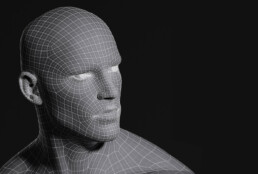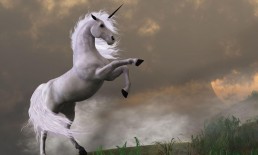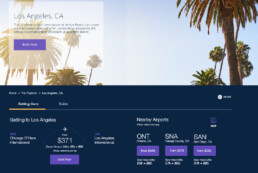Analytics to Predict Blockbusters
Analytics helps us to connect pieces of research, identifying the right elements to create a unique experience. “Jurassic World” movie is the perfect case study on how research, facts and behaviors can support a multibillion dollar franchise.
Not Another Sequel
We all went ”ugh… please-not-another-sequel!” when we heard the rumor of a Jurassic Park sequel. Apparently, we were wrong. Against all odds and rumors, the dino-action sequel literally ate box office records, with a staggering 208.8 million domestically this weekend, making it the highest grossing opening weekend film of all time.
As of today, Mr. T-Rex is the richest dinusaur in the world. 1.672 billion USD box office worldwide. Raawrr!! Grossing a total of $652,270,625 in USA and $1,019,442,583 internationally. Roughly $600 millions are from Asian markets, China and South Korea leading in Asia; UK, France, and Germany in Europe and finally Mexico and Brazil in Latin America respectively.
The industry is changing the way they do business and technology is doing its part. Analytics tools had proven to be successful, making connections between pieces of research, identifying facts and behaviors. Jurassic World is relevant example of this The audience ‘body language’ was pretty clear: On that weekend, the re-post rate for Jurassic videos on YouTube was 45 to 1 (the average is 9 to 1). The trailer on the official Universal channel got 66.6m views (multi-channel networks money well invested) Twitter almost broke: #JurassicWorld peaked at 63K. The “conversation” for the film was very high and very positive on social media that weekend. Thousands and millions share trailers with their community, on multiple social channels. And that’s intent of purchase…like a kiss. Plus, no big sports events or soccer matches on TV that weekend. Add shirtless Chris Pratt and school calendars and TV were packed with dino-theme curricula. Finally, people just love seeing Pterosaurs munching on tourists! Go family-friendly entertainment! Jurassic World broke box office, scoring the biggest opening weekend in history with a sweet $511.8 million in tickets sales worldwide, outdoing even Harry Potter.
Timing is everything
“Jurassic World” was shrewdly positioned as the June blockbuster to beat, ceding April to “Furious 7” and steering clear of “Avengers: Age of Ultron’s” May release. After “Tomorrowland” flopped over Memorial Day, there was some gum-flapping among box office analysts about whether Universal erred in not putting “Jurassic World” over the four-day holiday. In retrospect, it was the perfect move. The box office, which was coming off of three consecutive lackluster weekends, needed to cool down before it could heat up again.
“You could see this coming after a number of films that didn’t live up to expectations,” said Jeff Bock, a box office analyst with Exhibitor Relations. “There was just this hunger for a big summer tentpole film.”
The studio benefited from timing of another sort. Over the past decade and a half, the fourth “Jurassic Park” saw various filmmakers and screenwriters, such as “The Departed’s” William Monahan and “I Robot’s” Alex Proyas, come on board before getting tossed aside after failing to find the right creative direction for the film. The tortured development worked in “Jurassic World’s” favor, giving it distance from “Jurassic World III,” which is generally considered to be the series’ nadir, and lending the franchise a feeling of freshness.
Premium formats are prime
The Indominus rex, basically a T-rex on steroids, demanded to be seen on the biggest, widest, most souped-up screens possible. That meant that “Jurassic World” got a major boost from premium large format and Imax screens, along with 3D showings. The sequel took in 48% of its domestic opening weekend receipts from 3D screens while setting new high-water marks for Imax and private label PLF screens.
Those formats were in their infancy when “Jurassic Park III” was in theaters — 3D was still a novelty and Imax was reserved for nature films.
“I use my kids as a bit of a barometer,” said Anthony Marcoly, president of worldwide cinema for 3D-maker RealD. “They’ve seen the ‘Jurassic Park’ movies before, but they’ve seen them on TV or DVD. They haven’t had a chance to see a ‘Jurassic’ movie on these big [premium large format] screens or in 3D. People wanted to be brought into the world of ‘Jurassic’ and to see it in a grand fashion and just be drawn into the story.”
It also helped that Trevorrow talked up the virtues of seeing “Jurassic World” with all the extra bells and whistles on promotional videos and by appearing before screenings at the Imax TCL Theater in Los Angeles.
“This is a shared experience,” he told the crowd at one of these events. “It’s why we go to the movies.”
The exhibition industry has taken its knocks for not keeping up with the digital revolution that has upended the entertainment landscape, but “Jurassic World’s” success with tinted specs and sprawling screens demonstrates the lengths that theaters have gone to differentiate their experience from the one found in the living room or at the keyboard. Times have changed, of course, but some of it’s for the better.
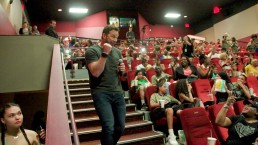
Dinosaurs ripping apart humans = appropriate for children of all ages
It’s been 26 years since “Jurassic Park” first illustrated the dangers of bringing velociraptors back to life, and in that time one generation of film fans has come of age and another has emerged. That means that a group of moviegoers who were first weaned on popcorn pics with that first film have grown up and were eager to introduce their sons and daughters to the magic of a T-rex rampage.
To familiarize a new group to the pleasures of the park, Universal reissued “Jurassic Park” in 3D in 2013 in conjunction with its 20th anniversary. It also primed the pump in a nice piece of corporate synergy, hosting a special presentation of “Jurassic Park” last week on NBCUniversal Networks that included interviews with Pratt and Spielberg. The film and TV stations share a corporate parent in Comcast.
The PG-13 rating made the prospect of seeing pterosaurs treat tourists like birdseed something of a family event. That resulted in an opening weekend crowd that was 39% under the age of 25, a demographic that hadn’t been born or was barely verbal when the first film debuted.
“We’re getting everybody and that includes parents with kids,” said Carpou.
Hollywood take note. That’s how you build a blockbuster.
Making Sense of fragmented audiences
Audiences consume and interact with information in unexpected ways, so you have to be tuned in real-time. Consider what’s going on in the analytics and reports, and out of them. Data is generated and delivered by the same audience you are trying to connect, from video channels, chat, social media and tweets. Paying attention to the ‘vibe’ or body language cues can go a long way. Use them to your advantage. Analytics can be tricky, but they are just the tip of the data iceberg. Keep your cool, be yourself and be responsive. Pick your actions accordingly and maybe it could be the start of an unforgettable relationship.
Yesterday afternoon, Marvel Studios showed some chivalry by releasing a poster (a tweet by president Kevin Feige) congratulating Steven Spielberg and the Universal Studios team, Director Colin Trevorrow and golden boy Chris Pratt for beating the hero team, since their lost their title as the previous record holder. With these numbers, we will be seeing more Jurassic (probably without ‘The Park’) in the future.
How VR is changing storytelling
3D Culture: a new perspective of life
Three-dimensional experiences can be traced to the early 1900s, experimenting with 3D-filmmaking. Around the same time, the concept of “Culture” as we know it now, started to shape up. Both disciplines were trying to create a vivid representation of an object, a situation or behavior in order to understand it. Scientists use mathematics or physics, while anthropologists use social concepts. More than 100 years passed already and we still trying to figure things out.
Virtual reality, 3D experiences, and three-dimensional selfies are part of the normal, so it’s organic to think about culture in a three-dimensional way, or what I like to call, 3D Culture. Borrowing from concepts from 3D modeling, we could say that it’s possible to create a model of an object (situation/moment). We should be talking about a “multiverse” approach, but let’s move in little steps. I worked plenty with 3D artists, XD designers and collaborated with researchers and analysts on multicultural projects, so inadvertently I became a 3D Cultural Analyst, rendering situations into models, creating a mental sculpture to have a 360 understanding. We model culture using our own algorithms (thoughts and perceptions) shape and texture our objects (experiences) and look at it from many angles (situations). Don’t worry if this doesn’t make sense, keep reading, we are almost there.

Our brain is an organic 3D living scanner, we collect information and data from many sources. We model situations, ideas, actions and behaviours based on new input and within our own archives and mental 3D library of emotions, thoughts, memories, sounds, smells and flavors. We give this objects meaning through texture mapping and create high poly experiences. The result is a beautiful, amazing 3D model of who we are and how we see the world. All in real-time.
This mentally interactive, three-dimensional cultural model reflects and shapes our story and how we behave, on a daily basis. Our ideas, thoughts and beliefs, even the music we listen, the food we like or the books we read are part of our 3D cultural model, shaping our identity and framework to our ‘why we do things the way we do’. And it’s passed down from one generation to the next one.
Culture is wide and filled with many layers, and naturally we tend to simplify things pre-modeled objects, royalty free-ideas of what something means. Words come with a significant amount of conceptual baggage. For example, think of the word “Argentina”. Did your mind conjured images of tango, gauchos and delicious steak?…and what about California…Hollywood and golden beaches? or India (colorful dances, spicy food and Ganesha). Or in reverse, the words ‘fiesta’, ‘nachos’ and ‘5 de mayo’ in a single phrase invoques the idea of Mexico. So wrong on many levels. The reality is that words convey powerful notions of “Argentinean” or “Indian” qualities. How people dress and eat is just part of it, and really a very small indicator of all the symbols, traits, diversity and depth that each amazing and unique culture. Also, culture exists beyond its ‘Wikipedia’ country description. Office buildings, universities, shopping markets, public transportation, coffee shops, anywhere people interact and share the same language, slang, interests and values creates culture: a subculture. They can be united by a music style, a game or a concept, food or sports, uniting complete strangers from around the globed, with opposite cultural into a single hearted vision.

Spoiler Alert! you can’t design for everyone.
But we can focus on a subculture and inspire culture from the inside-out, enabling ambassadors. This shift build space for growth, mixing innovation and design with relevant insights into the deeper layers of cultural behavior. Its an opportunity reinvent and a vibrant playground for talent to make better products and services.
People are people no matter which country you are, and you’ll find interests and tastes as diverse as their inhabitants. From gender identification, tradition, decision-making process and concepts of self. We could try to isolate subcultures using this parameters. Spoiler Alert! you can’t design for a whole culture. Appealing to everyone is a waist of resources and time. What we can is to focus on a subculture, inspiring culture from the inside-out as ambassadors. Become and real influencer. A 3D cultural approach allows us to take a fresh look into situations from various directions and views -like a 3D camera moving around a virtual scenario-. so we can identify opportunities and challenges and had a quick understanding without investing much time.
Subcultures thrive within culture and sharing similar values, beliefs or behaviors, but “updated” to reflect their current life experience. Happens a lot with expats for example, were we adapt our ‘mother-culture’ re-significating to continue cultural survival and cultural evolution. “Tex-Mex”, “Chinese-American” “Techno-Jazz” “Newyorican” are everyday simple examples. You can be Argentinian, speak spanish at home, polish with friends, and english at work Italian father and Argentine mother, raised in Buenos Aires, lived in the US half your life and living in Poland. That’s my crazy 3D cultural model.
3D cultural models are a multi-method approach using traditional tools, ethnographic observation, media investigation, data research, social behaviours and sub-cultural pointers to create a playground to analyse key and relevant findings. highlighted by cultural heritage, geographic momentum and social influences to generate a valuable framework to capitalise cultural-data opening new avenues for further research under the cultural-technological evolution umbrella. 3D cultural modelling gives flexibility to change angles quicker without re-formulating the scene, can easily help us calculate effects and behaviours, and get a subculture estimate with a 360 experience perception. This is not overriding classic techniques but a supportive framework to play with those variables, a view of the world through multiple lenses, from the individual to the collective, creating a storytelling that empowers, encourages and represents people transcending time, culture and language, and finally understanding that diversity is the one true thing we have in common.
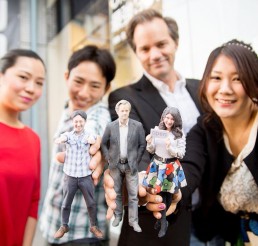
Wellness, the new luxury
Refreshing the concept of luxury
In China, a country renowned for its efficiency and high-performance workers, Gen Zers have embraced a more relaxed philosophy as a form of protest against a system they now feel is rigged for the rich and powerful. This ‘burnt out’ generation of discouraged millennials worldwide has been rebelling against unbalanced wages, intense work schedules, and a lack of job security, even before the pandemic, and after isolation and distress in result, people are looking to adjust their lifestyle to a more balanced, healthier experiences.
Many consumers have learned that comfort is more important than being fashionable. Wellness and self-care have suddenly become more of a priority than ever. Global brands should soon expect the traditional luxury fatigue. Although is a challenge, is not necessarily a bad thing, but is an opportunity to creatively refresh their portfolio and products offer, introduce new points of view that satisfy both needs. Wellness and aspirations.
Wellness and self-care have suddenly become more of a priority than ever and have the potential to revolutionize the luxury industry. Luxury brands can inspire this newfound awareness to create healthier and smarter lives.

Reducing the gap between traditional luxury through health and wellness
While consumers integrate wellness into every aspect of their daily lives, so there’s a new perfection that brands could change in their narrative. Outdated vertical luxury definitions fail to understand the convergence and multidimensional nature of wellness. Across sectors such as beauty, fashion, travel, and fitness, wellness is the world’s fastest-growing market segment. And affluent consumers are willing to pay a premium for perceived wellness solutions. Driven by Millennials, social media and online DTC retail, wellness brands can more easily grow globally.
Wellness has become a priority for most luxury consumers. A better understanding of the consequences of our lifestyle choices, and digital health trackers are contributing to inspiring modern affluent consumers to live healthier lives. Luxury brands need to integrate elements of wellness both in their offerings and marketing to capture increasingly health-conscious shoppers. An effective approach to wellness seizes opportunities to bolster a sustainable, healthy way of living whether through partnerships, cross-category expansions, and innovations, or new business models.
Affluent consumers demand natural and organic products. Fashion shoppers are drawn towards high-end athletic/leisure outfits both comfortable and stylish. Bars and restaurants are being replaced by gyms and fitness studios becoming new social hubs for affluent new generations.
The deep desire for health and wellness is radically reshaping what luxury brands need to offer to their consumers and how they communicate the value of their goods and services. Leading brands will be the ones whose efforts make positive contributions and empower consumers in their journey to wellbeing. Wellness is profoundly transforming the luxury industry. Brands creative, narrative and storytelling will benefit to incorporate elements of health and wellness that will resonate with the newfound awareness and new market.

Deepest renewal. La Mer’s iconic Miracle Broth™ reveals a bright, well-rested look.

Looking for a way to elevate your daily workouts or a way to turn heads at the gym? Louis Vuitton has just released the perfect accessory.
Inspire wellness through a new approach to luxury
On the domestic front, the retail industry has also experienced challenges since the onset of the pandemic. From margin pressure and shift to online shopping, affecting the footfall of domestic stores, malls, etc. Again, I believe all of this is a unique opportunity to create better digital experiences and cost-effective approaches, from creative to product development. The right digital initiative can help us measure effectiveness, traffic and better connect and engage with key stakeholders, inside company units, partners and audiences.
Through digital channels, with an aligned 360 vision across platforms, relevant narrative, brand commitment, proactive, small initiatives and MVPs that allow us to know better our audience and consumers, creating a customer experience that is engaging, personal, healthy, and valuable. Luxury brands are starting to catch up with the market trends into wellness awareness inspiring us to live healthier and smarter lives. A new luxury mindset, where the true luxury is reflected in wellness, comfort, and work-life balance. Accordingly, brands should be prepared for this new mindset that the YOLO economy has ushered in. In fact, today’s YOLO economy has the potential to revolutionize the luxury industry. COVID-19 was the catalyst, but this change was a long time coming.
UX Designers: Bestias Fantásticas y dónde encontrarlas.
Cada vez que me preguntan “¿Que es un diseñador de UX?” Lo primero que pienso es… ¿por donde empiezo?. Parecería que un especialista en UX es como un animal mítico del que todos hablan y, pocos han visto uno.
WTF es UX Design?
El primer punto en este camino es aclarar que que diseño de UX no es diseño visual. Muchos conectan equivocamente al especialista en UX con diseño gráfico y, viceversa, muchos diseñadores graficos son “diseñadores UX/UI” (esta mezcla de disciplinas me da miedo!!) Si bien ambas disciplinas comparten ADN, la realidad es que son dos criaturas muy distintas. El rol de un especialista en UX es muy diferente. Es importante tener una vision holistica de las disciplinas que intervienen para generar una experiencia de usuario, pero el profesional de UX es una bestia aparte, a menudo, incomprendida por las empresas, y considerada como un lujo. “El diseño no es sólo cómo se ve o cómo se siente: Diseño es cómo funciona”, nos dijo una vez Steve Jobs y, realmente estoy deacuerdo.
Diseñador es alguien que aplica metodologías y prácticas de Design Thinking para resolver cualquier tipo de desafíos, ya sea de negocios o personales. Quizás aplicas estos procesos durante tu dia y no te das cuenta. Yo he visto a mi madre “Prototipar” con post-its haciendo una lista de mercado y como podría ahorrar tiempo en el supermercado a partir de un diagrama de ‘navegación’ y sus ‘objetivos’ de compra.
El segundo punto en esta definición tienen que ver con el enfoque que se busca en cada proyecto o cliente. Para algunos, el rol del UX specialist va mas allá de la plataforma y ven a los usuarios como clientes que utilizan herramientas digitales para interactuar con las organizaciones y sus productos. Para otros, es una especialidad dentro de la experiencia del cliente, pero en cada uno de sus definiciones, el punto en común es el usuario.
El especialista UX busca representar y comprender al usuario -y aun mas allá de eso- educar a las organizaciones y equipos de trabajo, acerca de las necesidades, desafíos y puntos críticos de los mismos, y luego alentar al equipo, trabajando en conjunto para crear una mejor experiencia.
Perfiles de UX designers segun su background
INVESTIGADORES
Disciplina de nicho, muchas veces es considerada un lujo más que una necesidad. Los investigadores ayudan a las empresas a desarrollar un plan de investigación para conocer en profundidad a su publico y usuarios a través de diferentes metodologías. Encuestas, entrevistas, pruebas de usabilidad y resonancia de marcas, estudios etnográficos, etc, proveen a las empresas datos cuantitativos y cualitativos revelando preferencias, detalles, lógica de interacción y emociones para el uso de productos y cumplimiento de metas de negocio.
ESTRATEGAS
Desarrollan proyectos de investigación y diseño. Toman los datos y conclusiones obtenidos en la investigación y los sintetizan en un sistema de diseño de alto nivel, crean identidades o perfiles de usuario, escenarios y journeys. Los estrategas generan un sistema de diseño abstracto que sirve como modelo conceptual para crear un modelo concreto y real.
ARQUITECTOS DE INFORMACIÓN
Los arquitectos de información son el punto de transición entre la estrategia y el diseño, aportando una vision general del usuarios a quienes esta destinado el producto o servicio y resolviendo el diseño abstracto en una experiencia completa. Desarrolla los site maps, wireframes, describiendo en detalle cómo las interacciones del usuario deberían comportarse desde un punto de vista funcional.
DISEÑADORES DE INTERACCIÓN
Muy parecido a los AI, con la diferencia que su resultado proviene de la evaluación Heurística (EH), un análisis de usabilidad y calidad de uso de una interfaz desde patrones existentes, relación entre el sistema y el mundo real, consistencias y estándares, flexibilidad de uso, diseño minimalista y/o experiencia personal.
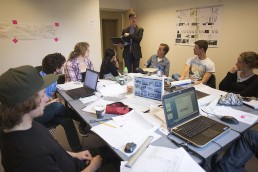
STORYTELLERS
Proporcionan una comprensión detallada de las estructuras de contenidos (noticias, sub-títulos, teasers, cuerpo, imágenes, etc.), taxonomías (estructuras jerárquicas para categorizar y relacionar el contenido) y el storytelling emotivo que forma la historia generando en una narrativa global que crea un impacto y adhesion en el usuario.
DISEÑADORES VISUALES
Los diseñadores visuales tomar el wireframe y lo convierten en diseño, recursos o assets necesarios para hacer un producto real. Muchos diseñadores cuentan con background en print, tipografías, identidad de marca, etc. Los buenos diseñadores visuales entienden que la usabilidad, elementos cognitivos y jerarquías de la UX pueden son afectados por color, tipografía y composición, teniendo un fuerte impacto en la experiencia de usuario más allá del atractivo estético.
INGENIEROS DE UI
Transforman los documentos de diseño en productos reales. Dependiendo del nivel de complejidad de los proyectos, pueden tener un background como ingenieros de software o experiencia en desarrollos web. Son pocos los profesionales de este subconjunto que puede realizar todo, desde investigación hasta implementación.
Espero esta mini guía sirva de ayuda a la hora de buscar un perfil, ya sea generalista, especifico o híbrido de estas disciplinas. Lo importante es tener en claro cual es el foco del proyecto o de nuestro cliente, nuestro primer usuario. Te comparto una frase de Donald Norman, un capo de la ciencia cognitiva, Co-Fundador del grupo Nielsen y ex VP de Investigación de Apple:
“No es suficiente que creamos productos que funcionen, que sean comprensibles y utilizables, también necesitamos construir productos que traigan alegría y emoción, placer y diversión, y además, la belleza de la vida a las personas”.
The new audience identity
Understanding your audience in this ever-complex marketplace requires a unique ability to combine massive amounts of measurement information with the right perspective.
While entertainment industry is changing the way they do business, technology is doing its part. Analytics tools had proven to be successful, making connections between pieces of research, identifying facts and behaviors. But if we want to understand how our audiences interact with our content, we might need to change how questions are made.
The New Audience Format
Spoiler alert. There's is no audience format anymore. Audiences have grown to become agnostic, nomadic, multi-tasking, experiential and very direct. There are no two viewers alike. In the same demographic, they might not share the same interests. Most of the time they are ‘uninspired’ by expensive Networks marketing extravaganzas. Options multiply with every tweet, facebook like or selfie ever taken. If you’re not reaching, engaging, and monetizing your audience, you’re likely losing them to someone else.
Changing the concept of engagement
When it comes to understanding, all the information you can get is important. But you have to be smart and sensitive in order to relate effectively. Read the signs, get feedback, and adjust your approach as necessary. Think of an audience in terms of a “first date”. Analytics can give you a way to read your audience “body language”. You’ll get tons of real time feedback. From measurement tools, analytics apps and marketing research, you get to embed with your product, and how much you can play out. It’s important to have all the details, but the key is to understand how to read the information. You got to be responsive.
A subtle smile, eye contact, mirroring, head-tilt, all require a bit of interpersonal sensitivity. Look at the trends in the social media; keep an eye on relevant comments. The right timing or even the weather can give you a metric that algorithms might have missed. Take a moment, observe, and the pointers will become visible. You’ll actually see your audience ‘body language’ the way Neo sees The Matrix.
A relevant example is the movie Jurassic World. The audience ‘body language’ was pretty clear: On that weekend, the re-post rate for Jurassic videos on YouTube was 45 to 1 (the average is 9 to 1). The trailer on the official Universal channel got 66.6m views (multi-channel networks money well invested) Twitter almost broke: #JurassicWorld peaked at 63K. The “conversation” for the film was very high and very positive on social media that weekend. Thousands and millions share trailers with their community, on multiple social channels. And that’s intent of purchase...like a kiss. Plus, no big sports events or soccer matches on TV that weekend. Add shirtless Chris Pratt and school calendars and TV were packed with dino-theme curricula. Finally, people just love seeing Pterosaurs munching on tourists! Go family-friendly entertainment! Jurassic World broke the box office, scoring the biggest opening weekend in history with a sweet $511.8 million in tickets sales worldwide, outdoing even Harry Potter. Universal Studios had a nice date!
Conclusion. Audiences consume and interact with information in unexpected ways, so you have to be tuned in real-time. Consider what’s going on in the analytics and reports, and outs of them. Data is generated and delivered by the same audience you are trying to connect, from video channels, chat, social media and tweets. Paying attention to the ‘vibe’ or body language cues can go a long way. Use them to your advantage. Analytics can be tricky, but they are just the tip of the data iceberg. Keep your cool, be yourself and be responsive. Pick your actions accordingly and maybe it could be the start of an unforgettable relationship.
How to create a hit with a low budget and a clever strategy
Deadpool has always been a fairly popular Marvel character among hardcore fans, but relatively unknown to the rest of the world…until today. He’s a kind of quirkish, snarky anti-hero with a natural ability to break the fourth wall to communicate with his readers/audience, usually to mock the super hero cliché. Against all odds, Deadpool made it to the big screen, and compared to others in the same genre, with a tiny $58 million budget.

From the buzz and temperature of social conversations from these past weeks, looks like Deadpool is going to break some barriers over the weekend and the people at Fox and TSG(financiers of Fox live action movies) are going to be celebrating next week. Why? Because they had created a hit out of nowhere. And off course, the movie is pretty entertaining, despite the R rated label. Looks like someone at Fox marketing is planning and executing the right way some key strategic moves:
1.Release date
Deadpool probably will beat their weekend competition in this long president weekend.Zoolander 2 have drawn on nostalgia viewership and also a good campaign to cash on tickets to save the day. And How to be Single, the Dakota Johnson romantic flic, well…is just that. Deadpool release date feels like it was “under the radar” in the distribution timeline because there are literally not many movies for grown-up audiences to go. Big Oscars contenders have their on fight last week, Fifth Wave is a bore, and Zootopia is due next week, so Deadpool has a green wave to rise above the numbers. Plus, is Valentine weekend, with basically no “The Notebook” movies in sight. So this quirky potty-mouthed anti-hero is the royal ambassador of anti-valentine audiences.

2.Marketing Campaign
We all know that a box office hit need good PR and Marketing strategy, but honestly, most of the studios FAIL on these matter, and don’t tell me because of the budget. Advertising is not all about showing the movie trailer or character posters here and there. Its about building a brand. The marketing around the upcoming film has been nothing short of phenomenal, deserving of a glowing five out of five chimichangas. The trailers and promos for the film have all been tongue in cheek and absolutely hilarious, playing off of different trends and tropes to create unique communications. Seriously, if the ads are this good, just imagine what awaits fans in the theaters (eat your heart out Star Wars). Even they did a Valentine style campaign that is just brilliant

3.Social Media Strategy
We’re living in a postmodern, meme-culture, hero over saturated age. Audiences are CRAVING for some originality. No more remakes, no more sequels, no more cinematic universes with happy meal toys and epic superhero faces in a box of cornflakes. Deadpool itself is a bit of a snarky commentary on the over exposure of the genre, even an R-rated very violent superhero movie, but guess what, its unique. The audience age is that perfect 18-34 years old, which are highly social users. So, its no surprise that online conversations about Deadpool are hot on Reddit, Facebook, Twitter, YouTube, Instagram, you name it, where fans can engage and engage others. The movie has been promoted virtually only through social media. In fact, the movie was only green-lit after test footage was “leaked” on social media. Fox released a red-band trailer unsuitable for TV, and the movie landed an R-rating. So marketing made up for the lack of television ads with their creative social media campaign. During the holidays, they spoofed the 12 Days of Christmas, with #12DaysofDeadpool, which spotlighted special content released each day. The content included downloadable videos, pics and emoji’s. And also took over Valentines with fake gushy romantic Ads all over the internet and street billboard.

The big man @ ComScore, Paul Dergarabedian, said this today about Deadpool: “This may be the first movie of 2016 that kind of elevates everything, and gets that box office momentum charged.” Sweet remark. Again, its all about building a brand.
The movie is also off to an impressive start overseas, with a tracking of more than $90 million for the weekend. Deapool is on fire at the box office today: it began playing at 7 p.m. in 2,975 locations; on Friday, it expanded into a total of 3,558 runs, including Imax locations. The Imax portion of Thursday night’s haul was $2.3 million, the sixth biggest preview ever for the large-format circuit.
Once ranked nr. 182nd out of 200 in the popularity list of Marvel properties, Deadpool is on its way to become a success. The movie probably step over the heels of Guardians of the Galaxy ($94.3 million) and Captain America: The Winter Soldier($95 million) and likely score the biggest R-rated opening of all time. Tip of the hat to the marketing team @ Fox.
Deadpool, starring the sexy-mouthy Ryan Reynolds, beautiful Morena Baccarin, Ed Skrein, T.J. Miller and Gina Cara, all directed by Tim Miller.
Creating value through data
Creating a cost-efficient experience
Development, printing, and shipping more than a million Premiere Status Kits around the world were costly in resources and production. We needed to create not just a great experience that communicates that delivers the information, but also the value and experience that each tier deserves and also create opportunities for business.
A solution that brings value to the business and the users.

Understanding what’s more valuable for our customer
Change the color to match your brand or vision, add your logo, choose the perfect layout, modify menu settings, add animations, add shape dividers, increase engagement with call to action and more.
We started our journey-mapping initiative looking for existing, relevant data both qualitative (from past focus groups, customer-support logs, social media feedback) and quantitative (analytics, customer-satisfaction scores, etc.) to get a detailed understanding of our customer’s general attitudes and levels of satisfaction for specific interactions, and uncover missed opportunities and implementing new ideas.
